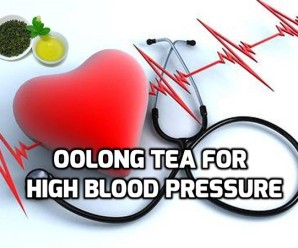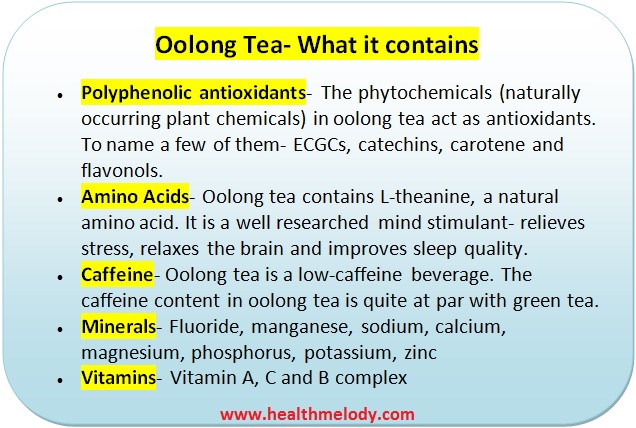
Oolong tea for high blood pressure (hypertension)
Oolong tea is a low-caffeine, natural drink with health benefits quite similar to green tea. People prefer it over green tea because of its mild, pleasant taste. It is a perfect alternative for those habitual coffee (or black tea) drinkers who wish to switch over to healthier options, but, just can’t handle the grassy, bitter taste of green tea.
Regular consumption of oolong tea can help reduce blood pressure and cholesterol levels to improve cardiovascular health.
A study involving more than 76000 Japanese adults in the age group 40 to 79 observed that drinking one or more cups of oolong tea everyday in the long run can reduce the risk of mortality from cardiovascular diseases by almost 61%.
Read more: Yoga for High blood pressure
Oolong tea- in brief
Oolong tea is a traditional tea, has been widely consumed in China and Taiwan for last 400 years. The same raw material (tea plant) is used to manufacture oolong tea as for green tea and oolong tea.
So how they differ?
The degree of fermentation (oxidation) varies during tea manufacturing. For black tea, the tea leaves are highly oxidized till they turn black where as for green tea, the leaves go almost unoxidized. The oolong tea is semi (partially) oxidized. That’s why it lies in between green tea and black tea in terms of taste and health benefits.
The local Chinese name of oolong tea is Wu long tea.
How caffeine affects high blood pressure
There can be a temporary spike in blood pressure for those people who consume caffeine rarely (or occasionally). However, no such phenomenon is observed in regular (habitual) caffeine drinkers.
According to a review published in the Archives of Internal Medicine, May 1988- people who don’t drink caffeinated drinks regularly may experience a spike in their blood pressure levels during the initial days of consumptions. But, this effect would fade away with regular consumption and blood pressure level would return back to the baseline.
In general, people with high blood pressure are advised to cut down on daily caffeine intake to manage the symptoms.
One cup of coffee (brewed) contains around 100 mg of caffeine. Hence, limit your daily coffee intake to 2 cups.
How much caffeine in one cup of Oolong tea
Numerous factors can affect the caffeine content in any tea-
- Tea plant farming (growing) conditions
- Tea manufacturing procedure
- Tea brewing variables like steeping time, temperature of water and tea bag or loose tea leaves.
That’s why caffeine content is better suggested in ranges than quoting an exact number.
Various attempts have been made to measure the caffeine content in commercially available tea varieties and general ranges are suggested as below:
- Oolong tea is low in caffeine- almost one-fourth that of brewed coffee when consumed in the same quantity.
- The caffeine content in oolong tea is quite comparable to that of green tea.
Benefits of Oolong tea for High blood pressure (hypertension)
Stress and obesity are among the most prominent causes of high blood pressure. Also, diabetic people are at high risk of developing high blood pressure.
According to the Blood Pressure Association, also known as Blood Pressure UK- around 25% of the people with diabetes type 1 and 80% of the people suffering from diabetes type 2 have high blood pressure. In short, most of the diabetic people develop high blood pressure during their life.
Let us discuss how oolong tea is going to tackle these issues:
- Anti-obesity activity of Oolong tea
Thanks to the catechins (polyphenolic antioxidants) and caffeine, oolong tea boosts the body metabolism to speed up the calorie burning rate. It would facilitate optimum breakdown of accumulated body fats to reduce obesity.
A study reported in the Journal of Medical Investigation, Aug 2003 observed that drinking oolong tea can increase the body metabolism by 10% in comparison to drinking plain water. This effect lasted for 2 hours after drinking the tea.
A study reported in the International Journal of Obesity, Jan 1999- evaluated the anti-obesity activity of oolong tea. The obese mice, fed on a high-fat diet were administered oolong tea for 10 weeks. It resulted in significant reduction in obesity as well as fatty liver symptoms.
Read more: Slippery elm for weight loss and digestion
- Reduces stress
In today’s hectic daily routine, a life full of stress and anxiety has become a new normal. In our efforts to fulfill the commitments related to work, family and society- it is so obvious to get stressed.
In a stressful situation, the brain stimulates the central nervous system to produce large amounts of stress hormones (cortisol and adrenaline). These stress hormones increase the heart rate and cause constriction of blood vessels. The constriction (narrowing) of blood vessels would eventually lead to high blood pressure.
According to a review published in the Wisconsin Medical Journal, Dec 1998- chronic stress and anxiety can cause continuous elevation in blood pressure which may lead to hypertension in the long term.
How oolong tea is going to help de-stress yourself?
Oolong tea performs better than coffee when it comes to stress relief because coffee contains only caffeine whereas oolong tea contains an incredible combination of caffeine, theanine and antioxidants.
⇒ Theanine (or L-theanine) is a naturally occurring amino acid in oolong tea with psycho-protective properties. It relaxes the mind without inducing drowsiness. It inhibits the overproduction of cortisol (stress hormone) and at the same time, boosts the alpha brain waves. The overall impact is- relaxed mind, positive mood and better clarity and concentration.
⇒ The oxidative damage caused by free radicals in the brain can cause nervous system impairment to worsen the symptoms of stress and anxiety. The antioxidants, particularly ECGCs and catechins in oolong tea can successfully neutralize the free radicals to halt this damaging process.
⇒ Caffeine is another naturally occurring compound in oolong tea which is good for your brain when consumed in moderation. It is a well known brain stimulant- improves concentration, alertness and refreshes the mood.
Read more: Quick yoga for stress relief
- Helps to prevent and control diabetes
In general, all the teas- black, green and oolong- are found to be useful in reducing the risk of developing type 2 diabetes.
The polyphenol antioxidants in oolong tea help reduce blood sugar levels and improve insulin sensitivity to reduce the risk of developing type 2 diabetes.
A review published in the Archives of Internal Medicine, July 2004- reported that habitual oolong tea consumption- half cup or more for a period of 1 year reduces the risk of diabetes by 46% in the Chinese population.
A case study published in the health journal- Diabetes Care, Jun 2003- concluded that oolong tea can be used as a supplement along with regular medicines to further reduce the blood sugar levels. A total of 20 people dealing with type 2 diabetes consumed 6 cups of oolong tea every day for a period of one month. At the end of the case study, the average blood sugar level dropped by 30%.
How much oolong tea for high blood pressure
The recommended dosage is 3 cups of oolong tea every day, preferably one hour after the meals. Don’t drink it along the meals otherwise the tea antioxidants and caffeine can interfere with the absorption of food nutrients.
Avoid drinking it before the breakfast (empty stomach) as it can irritate the gut.
Side effects and precautionary measures
Being a traditional natural beverage, oolong tea is safe to consume for people of all ages. You can consume 3-4 cups of oolong tea everyday for as long as you want without bothering for any side effects.
To be on the safer side, pregnant women, nursing ladies and people with chronic health conditions should consult their physician before consuming oolong tea.
Over consumption (more than 6 cups per day) can impose side effects related to caffeine abuse:
- Insomnia
- Frequent urination
- Headache
- Nausea
- Hyperacidity
- Rapid heart beat
- Bloating
From where to buy
The taste and color of oolong tea would vary as per the degree of oxidation.
- The less oxidized tea would be fruity, earthy in taste and light green (golden) in color.
- The more oxidized tea would be creamy in taste and dark brown in color.
To buy some good quality, organic (pesticide free) oolong tea, please check below Amazon links:
If you are from USA, click here to check
If you are from UK, click here to check
If you are from India, click here to check
Conclusion
Benefits of oolong tea for high blood pressure are well researched. But, oolong tea along wouldn’t do any magic. You need to include radical changes in your diet and lifestyle for long term relief. Regular physical workout and yoga would be of great help as well.
References
https://www.ncbi.nlm.nih.gov/pubmed/19996359
https://www.ncbi.nlm.nih.gov/pubmed/19996359
http://www.efsa.europa.eu/en/press/news/150115
http://lpi.oregonstate.edu/mic/food-beverages/tea
http://www.bloodpressureuk.org/BloodPressureandyou/Yourbody/Diabetes
https://www.ncbi.nlm.nih.gov/pubmed/13678386
https://www.ncbi.nlm.nih.gov/pubmed/15277285
https://www.ncbi.nlm.nih.gov/pubmed/10094584
https://www.ncbi.nlm.nih.gov/pubmed/9894438
https://www.ncbi.nlm.nih.gov/pubmed/9894438
https://www.ncbi.nlm.nih.gov/pubmed/12766099






